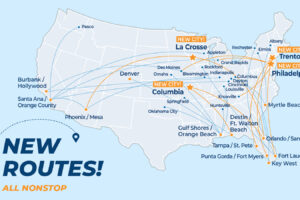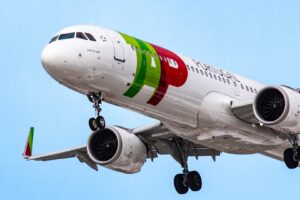
Southwest Airlines
built its original business model on being a low-cost carrier (LCC) while keeping costs low by flying to secondary airports in major US cities. From its original base at Dallas Love Field to its subsequent dominance at airports like Chicago Midway, Houston Hobby, and Oakland, Southwest has been highly effective at bringing competition to a particular market even as it avoided its main airport.
Southwest Airlines
IATA/ICAO Code
WN/SWA
Hub(s)
Baltimore/Washington International Thurgood Marshall Airport, Dallas Love Field, Denver International Airport, Harry Reid International Airport, Hartsfield-Jackson Atlanta International Airport, Houston Hobby Airport, Los Angeles International Airport, Midway International Airport, Oakland International Airport, Orlando International Airport, Phoenix Sky Harbor International Airport
Year Founded
1967
Expand
Yet at the height of the pandemic, Southwest entered a new market that didn’t seem to make much sense: Miami. It’s definitely not a secondary airport, being a major hub for rival American Airlines, and Southwest already had a massive operation just up the road at Fort Lauderdale-Hollywood International Airport
(FLL). So why would the Dallas-based carrier choose to fly here, especially at a time of heightened risk when most airlines were taking a hatchet to their route networks?
Multiple Reasons To Move To Miami
Photo: BlueBarronPhoto | Shutterstock
As you might expect, there was more than one reason why Southwest chose to launch new routes from Miami. It was the height of the pandemic, so it certainly had aircraft available, and Florida was one of the first states to start emerging from lockdowns. So, like numerous other airlines that were adding flights to the Sunshine State, Southwest was looking for some short-term wins in the few places where traffic might be bouncing back.
Pre-pandemic, Southwest would likely have thought twice before placing bets on routes at a major hub of a legacy carrier. But the pandemic had hit American Airlines just as hard, and with a severely reduced domestic schedule and its international travel to Latin America and the Caribbean all but shut down, there were plenty of open gates for Southwest to move into.
But there was also a long-term aspect to this move. Southwest was responding to a changing market and adjusting its strategy to keep up. Operating solely at secondary airports had become a risk: It faced increased competition there from other LCCs, its passengers wanted a choice, and the market didn’t have the same depth as before the pandemic, so it needed to spread its network wider. Let’s take a closer look at each of the reasons.
FLL Is Not What It Used To Be For Southwest
Photo: Markus Mainka | Shutterstock
When Southwest started flying to South Florida in the mid-1990s, Fort Lauderdale was the perfect location for its growth strategy. A secondary airport just 30 miles from a major US city, it welcomed the fast-growing LLC and was able to offer plenty of gates to expand rapidly. Southwest set up a base and helped FLL more than double its traffic over the next decade, growing from less than 10 million annual passengers to more than 22 million.
Today, Southwest flies to over 30 destinations from Fort Lauderdale and will operate an average of 70 daily flights this month.
Southwest’s Top 5 Destinations From Fort Lauderdale
Destination
Distance (miles)
Frequency
Baltimore
927
7x daily
Nashville
793
4x daily
Chicago
1,168
3x daily
Dallas
1,105
2x daily
Houston
955
2x daily
But Southwest’s success at FLL did not go unnoticed, and within a few years, Fort Lauderdale was becoming something of an LCC hub. Spirit Airlines established a base there in 2002, and JetBlue named it a focus city in 2003. Competition began to heat up, so much so that legacy carriers began to retreat – United Airlines abandoned FLL entirely in 2008.
As a result, Southwest today only has about a 15% market share at Fort Lauderdale, far from the level of dominance that it has at some of its other secondary airports.
Southwest’s Market Share At Select Secondary Airports
Airport
Market Share
Dallas Love Field
96%
William P. Hobby Airport
93%
Chicago Midway International Airport
91%
Oakland International Airport
82%
Fort Lauderdale–Hollywood International Airport
15%
JetBlue, Allegiant, and Frontier all have a strong presence at Fort Lauderdale. But Southwest faces especially strong competition from Spirit, which has twice the market share and number of routes, and a far more expansive network to the Caribbean and Latin America. This places significant downward pressure on ticket prices, and with Southwest now more of a hybrid operator, it is typically far from the lowest-cost operator at the airport.
Related
Southwest Airlines’ Big Shift: All The Changes At The World’s Largest Low-Cost Carrier
The Dallas-based airline has announced a raft of changes that are causing an uproar with its most loyal customers.
Miami Augments The South Florida Operations
Photo: Markus Mainka | Shutterstock
Southwest detailed its plans to expand to Miami in September 2020. It started with four routes, all of them significant Southwest bases, with Dallas and Houston being new destinations from Miami.
Southwest’s First Destinations From Miami
Destination
Distance (miles)
Frequency
Baltimore
947
4x daily
Houston
953
3x daily
Tampa
204
3x daily
Chicago
1,183
1x daily
It was an eye-catching announcement because at the time, the industry had been going through months of drastic route cuts, so expansion ran against the grain. At the time, CEO Gary Kelly was emphatic that the move was to augment its presence in South Florida rather than replace its operations at FLL, saying:
“Just as we serve multiple airports in metro areas across the country, South Florida is ripe for another. Miami will complement and augment our existing South Florida service we have in Fort Lauderdale and West Palm Beach.”
He also made the very valid point that the strategy was low-cost and low-risk, because Miami was an existing maintenance base for Southwest. “Miami already sees multiple Southwest aircraft on a weekly basis as part of our maintenance program,” he pointed out, “so adding an ability for our customers to travel there with us is a win for everyone.” But there were also some much deeper strategies at play with the move.
A Steady Shift By LCCs To Primary Airports
Photo: Markus Mainka | Shutterstock
Back in the 70s and 80s, when Southwest was the only significant LCC, it set up shop at secondary airports to keep costs low, but also to avoid direct conflict with the many, much larger legacy carriers. However, with LCCs now operating a third of US commercial air traffic, Southwest faces increased competition at the secondary airports and needs to spread its bets, including expanding to primary airports. This is especially the case in Florida, where LCCs now account for nearly half of all flights.
When asked if expanding to Miami, the type of airport with high operating costs that Southwest typically avoided, marked a change in strategy, Kelly pointed to Boston as a prime example of how the secondary airport strategy has changed:
“Boston sort of is the analogy to the Fort Lauderdale question. We were serving the Boston Metro area with alternative airports, such as Manchester, New Hampshire, and Providence, Rhode Island. And that strategy worked beautifully as long as we were the low-fare, low-cost carrier. That all changed because you had a lot of copycat airlines taking a page out of the Southwest book, and turning up with a more low-fare, low-cost approach. We needed to cover all bases, and so added Logan to our network.”
Thus, when JetBlue opened its Boston base in 2006, and Spirit added Boston to its network just a few months after, Southwest chose to land in the city just two years later. However, it still maintains extensive service to Manchester and Providence, showing its strategy to spread its catchment area.
Related
Southwest Airlines’ Most Popular Boston Routes By Seat Count
Five out of the six destinations have multiple daily flights scheduled.
A Shift To Broader Rather Than Deeper Networks
Photo: Markus Mainka | Shutterstock
We also need to remember the context behind the decision to start flights from Miami. Southwest was reporting dramatic losses, and while it had cut fewer flights than its competitors (about a third of all flights in 2020), it had excess capacity sitting on the ground that was ready to be used. And with fewer business travelers flying, the carrier no longer needed shuttle-like frequencies on many of its routes. As Kelly explained at the time:
“What’s happened is there’s no depth in the market. Routes that used to have ten flights a day can now maybe sustain two at the most. So we see this as an opportunity for us to go back to that list of cities that we can potentially add to our route map and add new customers, or build out new itineraries for our customers.”
So, whereas in the past it might have made more financial sense for Southwest to add an eighth daily flight between Dallas and Chicago, it now had to spread the net wider. With the pandemic also having crippled American Airlines, Miami was now an option where Southwest could be competitive. Indeed, as Southwest, Delta Air Lines, and other LCCs started moving in and expanding in Miami.
Other Good Reasons For Southwest To Add MIA
Photo: Markus Mainka | Shutterstock
While Kelly insists that the move to Miami was strategic, there is no denying that there was a tactical angle as well. Southwest needed some short-term gains to stop the bleeding, and with Florida being one of the first states to emerge from lockdowns, Miami offered a rare opportunity to add revenues from winter sun-seekers in 2020-2021. For the same reasons, Southwest also launched flights to Palm Springs at the same time.
Kelly admitted as much in a Q&A with the press a few months later:
“COVID-19 cases had spiked, and our business had flat-lined, and we were way off our trend lines. We needed additional dots on the map to provide new sources of revenue at a time when we really needed it. That was our number one challenge; we had cut our expenses, but the real need was to generate more customers and more revenues quickly.”
There was also a convenience factor involved. As travel has become more complicated, fewer travelers are willing to accept inconvenience to save a few bucks. While Fort Lauderdale is just 30 miles north of downtown Miami, the travel along I-95 is unpleasant at the best of times and prone to long delays, so business travelers and tourists (especially those for cruise ships) might strongly favor MIA. Also, Southwest has the opportunity to compete as a connector to the far more extensive international network at Miami.
We should also accept that Southwest in the 2020s is very different from decades before. It is no longer the low-cost leader, easily undercut by Spirit and Frontier. As its upcoming retrofits add premium seats and emphasize the upper tiers of its loyalty program, it is increasingly a “hybrid” operator. Some of the decision-making at its Dallas headquarters might simply have been that it feels more comfortable competing with American Airlines at Miami than Spirit, Frontier, and JetBlue at Fort Lauderdale.
Related
Southwest Airlines Will Begin Cabin Retrofits In May
Southwest will offer extra legrrom seats and assigned seating stating later this year.
The Result: Strong Growth For Southwest In MIA
Photo: Southwest Airlines
The decision to establish itself in Miami has proven to be a successful one for Southwest. Rather than retreat from Miami as the pandemic receded, it has grown significantly in the intervening years. It now flies to 15 destinations with an average of 32 daily flights in and out of MIA. This includes numerous airports such as Indianapolis, Kansas City, Columbus, and Islip that are not Southwest bases.
Southwest’s Top 5 Destinations From Miami
Destination
Distance (miles)
Frequency
Baltimore
947
4x daily
Nashville
807
2x daily
Chicago
1,107
2x daily
Dallas
1,105
1x daily
Houston
953
1x daily
Ironically, as Southwest has found growing success in Miami, it has reconsidered its investment in Fort Lauderdale. It recently announced the closure of its satellite base there, which is smaller than its main bases and serves the carrier’s flight attendants, not pilots. While this is primarily the result of cost-cutting exercises forced on the airline, its diversification across South Florida has enabled it to make the decision.
Related
Southwest Airlines Closes Crew Bases In Austin & Fort Lauderdale
The airline is trying to optimize its fleet and network amid a larger cost-cutting measure.






